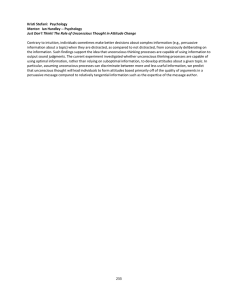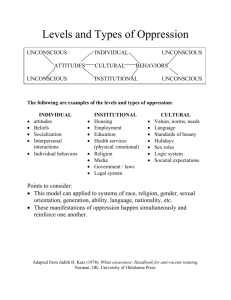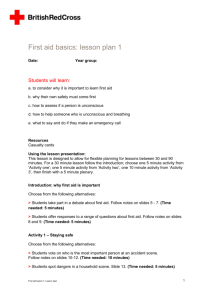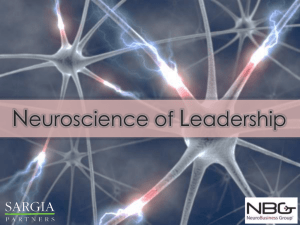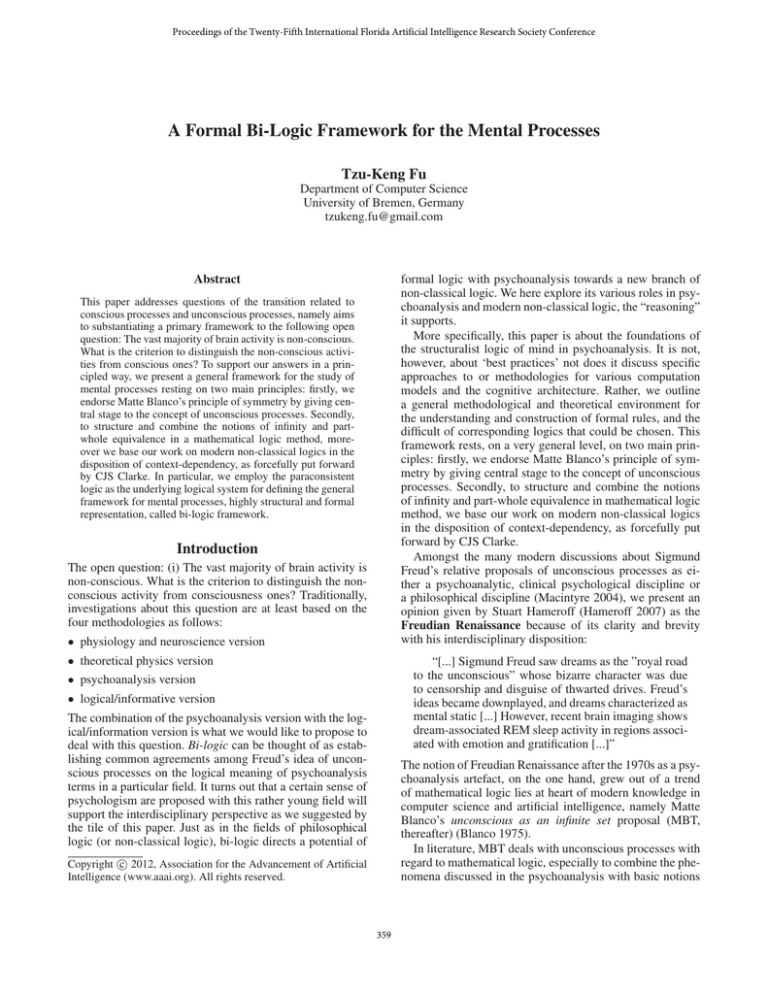
Proceedings of the Twenty-Fifth International Florida Artificial Intelligence Research Society Conference
A Formal Bi-Logic Framework for the Mental Processes
Tzu-Keng Fu
Department of Computer Science
University of Bremen, Germany
tzukeng.fu@gmail.com
Abstract
formal logic with psychoanalysis towards a new branch of
non-classical logic. We here explore its various roles in psychoanalysis and modern non-classical logic, the “reasoning”
it supports.
More specifically, this paper is about the foundations of
the structuralist logic of mind in psychoanalysis. It is not,
however, about ‘best practices’ not does it discuss specific
approaches to or methodologies for various computation
models and the cognitive architecture. Rather, we outline
a general methodological and theoretical environment for
the understanding and construction of formal rules, and the
difficult of corresponding logics that could be chosen. This
framework rests, on a very general level, on two main principles: firstly, we endorse Matte Blanco’s principle of symmetry by giving central stage to the concept of unconscious
processes. Secondly, to structure and combine the notions
of infinity and part-whole equivalence in mathematical logic
method, we base our work on modern non-classical logics
in the disposition of context-dependency, as forcefully put
forward by CJS Clarke.
Amongst the many modern discussions about Sigmund
Freud’s relative proposals of unconscious processes as either a psychoanalytic, clinical psychological discipline or
a philosophical discipline (Macintyre 2004), we present an
opinion given by Stuart Hameroff (Hameroff 2007) as the
Freudian Renaissance because of its clarity and brevity
with his interdisciplinary disposition:
This paper addresses questions of the transition related to
conscious processes and unconscious processes, namely aims
to substantiating a primary framework to the following open
question: The vast majority of brain activity is non-conscious.
What is the criterion to distinguish the non-conscious activities from conscious ones? To support our answers in a principled way, we present a general framework for the study of
mental processes resting on two main principles: firstly, we
endorse Matte Blanco’s principle of symmetry by giving central stage to the concept of unconscious processes. Secondly,
to structure and combine the notions of infinity and partwhole equivalence in a mathematical logic method, moreover we base our work on modern non-classical logics in the
disposition of context-dependency, as forcefully put forward
by CJS Clarke. In particular, we employ the paraconsistent
logic as the underlying logical system for defining the general
framework for mental processes, highly structural and formal
representation, called bi-logic framework.
Introduction
The open question: (i) The vast majority of brain activity is
non-conscious. What is the criterion to distinguish the nonconscious activity from consciousness ones? Traditionally,
investigations about this question are at least based on the
four methodologies as follows:
• physiology and neuroscience version
• theoretical physics version
“[...] Sigmund Freud saw dreams as the ”royal road
to the unconscious” whose bizarre character was due
to censorship and disguise of thwarted drives. Freud’s
ideas became downplayed, and dreams characterized as
mental static [...] However, recent brain imaging shows
dream-associated REM sleep activity in regions associated with emotion and gratification [...]”
• psychoanalysis version
• logical/informative version
The combination of the psychoanalysis version with the logical/information version is what we would like to propose to
deal with this question. Bi-logic can be thought of as establishing common agreements among Freud’s idea of unconscious processes on the logical meaning of psychoanalysis
terms in a particular field. It turns out that a certain sense of
psychologism are proposed with this rather young field will
support the interdisciplinary perspective as we suggested by
the tile of this paper. Just as in the fields of philosophical
logic (or non-classical logic), bi-logic directs a potential of
The notion of Freudian Renaissance after the 1970s as a psychoanalysis artefact, on the one hand, grew out of a trend
of mathematical logic lies at heart of modern knowledge in
computer science and artificial intelligence, namely Matte
Blanco’s unconscious as an infinite set proposal (MBT,
thereafter) (Blanco 1975).
In literature, MBT deals with unconscious processes with
regard to mathematical logic, especially to combine the phenomena discussed in the psychoanalysis with basic notions
c 2012, Association for the Advancement of Artificial
Copyright Intelligence (www.aaai.org). All rights reserved.
359
Recall that it is straightforward that in the continuum of conscious and unconscious processes should be paraconsistent,
since the observable phenomena in unconscious processes:
the absence of mutual contradiction and negation and the
co-presence of contradiction (Fu 2012). Thus, it is nature to
specify any paraconsistent logic as the underlying logics of
the conscious processes and unconscious processes, respectively.
used in the mathematical logic to study the unconscious processes, of which the emotions play the key role (Blanco
1988) (Rayner 1995). Although classical reasoning is still
predominant in current trend of various practices in computer science, it has been realized in recent years that there
are many different application stories by means of monclassical reasoning, for example, default and non-monotonic
reasoning, paraconsistent reasoning, or various uncertain
reasoning, and quantum reasoning. In the same way, some
relative developments in this trend about non-classical logics could have been studied to the proposal of MBT.
Quantum logic, for instance, is important in the comparison with bi-logic, in particular when both of them could be
seen as a sort of context-dependent logic based on a sheaftheoretic framework (Clarke 2006). Paraconsistent logic as
another instance is quite important in this paper, in particular
when reviewing the characteristics in unconscious processes
formulated by Freud, it is easily derived that the logic for
the continuum of conscious and unconscious processes (or
symmetrical-continuum) would be paraconsistent, i.e. to tolerate inconsistency without following anything, knowm as
ex contradictione sequitur quodlibet (Fu 2012).
The Difficulties in the Bi-logic Transition
Processes
We assume some acquaintance with the basic notion of paraconsistent logic and refer to (Béziau 2006) (Béziau 2000)
(Priest 2000) for an introduction. Here we do not discuss
whether to accept inconsistency but instead to articulate the
paraconsistency in the bi-logic framework. The rejection of
principle of explosion is sufficient to characterize the paraconsistency via either formulating a paraconsistent consequence relation or a paraconsistent negation. Here, the most
immediate difficulties to bi-logic framework intuitively is
perhaps given when classical logic and paraconsistent logic
are thought of as the underlying logics of conscious processes and unconscious processes, respectively in terms of
the mechanism of combing logics.
From MBT to Paraconsistent Framework
Like what philosopher Ludwig Wittgenstein has done in his
Tractatus Logico-Philosophicus, MBT treats “logic” as a
certain of formal method to analyze the psycho-analytical
concepts. The individual’s experiences of infinity and the
part=whole equivalence in the unconscious processes make
MBT formulate these two principles as follows: (Blanco
1975)
(i) Principle of generalization The system of unconscious
treats an individual thing (person, object, concept) as if
it were a member or element of a set or class which contains other members; it treats this set or class as a subclass
of a more general class, and this more general class as a
subclass or subset of a still more general class, and so on.
(ii) Principle of symmetry The system of unconscious treats
the converse of any relation as identical with the relation.
In other words, it treats asymmetrical relations as if they
were symmetrical.
It is straightforward that consequently a subclass may be
identical with any other subclass of the same class (Blanco
1975) (Blanco 1988) (Rayner 1995).
As described by psychoanalyst, Eric Rayner that the discrimination of difference is crucial to human life that requires the awareness of asymmetry to distinguish that some
things are not interchangeable with each other. Moreover, it
is also crucial to identify some things essentially the same as
another things, namely to have the registration of sameness
(Rayner 1995).
The study of these principles can be carried out to a quite
large extent independently of the details of the underlying logic translation processes that is widespread in theoretical computer science and ontology designs (Kutz et al.
2010) (Mossakowski et al. 2009) (Mossakowski et al. 2007).
Adopting the structuralist position that MBT has taken, we
explore the potential transition within bi-logic framework.
The styles of combining logics (Gabbay 1999) have already been widely discussed, among which the paradox of
combination are raised further (Béziau and Coniglio 2005)
(Béziau 2004) . Here in particular in the combination of
logic of conscious processes (LMCon) and logic of unconscious processes (LMUnc) that has already been proposed to formulate the bi-logic framework presented a major
difficulty, namely to question whether the combination of
LMUnc and LMCon is equivalent to the underlying logic
of the MBT. In other words, it means that we cannot claim
combining any two logics together arbitrarily.
The second difficulty is about the preservation of the
negation from LMCon to LMUnc. Mathematically speaking, given a negative proposition p1 ∈ LMCon, it can be
mapped to another negative proposition p2 ∈ LMUnc by
the sentence translation mapping (function). However, it has
been claimed that the unconscious processes are absent of
negation (Blanco 1988) (Blanco 1975) (Rayner 1995). Thus,
a given negative proposition p1 would become a positive
proposition p10 in LMUnc, such that p10 is equipped with
the same meaning as the negative proposition p1 in LMCon. According to the first difficulty, we cannot have arbitrary combination of two logics. Here it implies that we
can only pick the contradictory proposition either from LMCon or LMUnc. In this way, the contradictory proposition
cannot be specified in a purely formal, but instead we have
to check what “the meaning” and “the content” the propositions do really represent case by case. Here we encounter
a difficulty: no contradiction that purely by means of form
can be specified in LMUnc, as what we have always seen in
formal logic.
360
Context-dependence logic
1. h+punc | ¬ + pcon i
A potential framework which has been proposed by CJS
Clarke (Clarke 2008) (Clarke 2006) (Clarke 2005) that the
bi-logic framework is context-dependent could transcend
the above-mentioned difficulties. The meaning of contextdependent is as follows: Given a proposition p, p may be
true in one context but false in another. It argues that each
conjunct of a formal contradictory conjunction p ∧ ¬p might
belong to a context in content.
Context-dependent logic will not be formalized, but realizing the context-dependence in the bi-logic framework is
quite straightforward here. Given any proposition +p, −p,
+p means the positive propositions, −p means the negative
propositions, and the expression hQx | Ry i means propositions Q ∈ x, R ∈ y have truth value with the simultaneous
relation ( | ) and the unchanged context ( hi ), we are able
to list all possible cases for a proposition passing from the
conscious processes to unconscious processes as follows:
Group (1)
2. h+punc | ¬ − pcon i
3. h−punc | ¬ − pcon i (impossible case)
4. h−punc | ¬ + pcon i (impossible case)
In the ordinary paraconsitent logical systems, we do not
have to consider the persistence of context-dependency.
However, due to the very essence of bi-logic framework, we
have to make sure that a proposition follows the same context in the transition of two processes, such that we are able
to handle paraconsistency, while we enter to and get out of
the LMUnc.
Typically, any formal contradictory proposition p ∧ ¬p
was generated from the same one categories, that is the conscious processes. It is not from the unconscious processes
because of the absence of negation. The content contradictory propositions are not restricted in this way. Hence, while
we pick the contradictory propositions, it must be from 2
and 3 in group (1); 1 and 4 in group (2);*; 1 in group (5); 1
in group (7). Moreover, the concept of inference in LMUnc
should be held in a manner of accepting the symmetry principle, of which a deduction will generate some new propositions.
In order to understand the transition processes between
LMUnc and LMCon, let us discuss it in a bit more detail.
The usual concept of inference that has already happened
in LMCon would not happen as usual in the LMUnc. Two
reasons are as follows:
1. h+pcon | +pcon i
2. h+pcon | −pcon i
3. h−pcon | +pcon i
4. h−pcon | −pcon i
Group (2)
1. h+pcon | ¬ + pcon i
2. h+pcon | ¬ − pcon i
• The timelessness in LMUnc would fail the concept of inference used in common, of which the time-serial (timeness) has always characterized the concept of the inference in the LMCon.
3. h−pcon | ¬ + pcon i
4. h−pcon | ¬ − pcon i
Group (3)
• The symmetry principle (or the absence of negation) will
trivialize the concept of inference used in common (in
LMCon).
1. h+pcon | +punc i
2. h+pcon | −punc i (impossible case)
3. h−pcon | −punc i (impossible case)
With respect to the generalization of inference, we address
a question: How could people simultaneously grasp that a
set of propositions is inconsistent, of which contains p and
negation of p, when p is derived at time1 and the negation of
p is derived at time2 ?
While people are in the awareness state (or in conscious
processes) with the certainty to the same context of two
proposition p and ¬p, it is obvious that they will be confident
of grasping a set of inconsistent propositions. Formally,
Group (4)
1. h+pcon | ¬ + punc i (impossible case)
2. h+pcon | ¬ − punc i (impossible case)
3. h−pcon | ¬ − punc i (impossible case)
* h−pcon | +punc i (absent of negation)
Group (5) We list the propositions in the non awareness
states:
hpx ia −→ h¬px ib
1. h+punc | −punc i (non awareness)
h¬px ia −→ hpx ib
2. h−punc | −punc i (non awareness)
where ‘px (or ¬px ) in context a’ comes before ‘px (or ¬px )
in context b’. The following one is to consider the first case
in a more general but the same one context in the awareness
state:
hhpx ia −→ h¬px ib ic
Group (6) We list all possible cases for the reverse proposition passing:
1. h+punc | +pcon i
2. h+punc | −pcon i
hh¬px ia −→ hpx ib ic
3. h−punc | −pcon i (impossible case)
where a = b = c.
To be able to write down and be confident of this certainty
could we only in the conscious processes, such that we have
4. h−punc | +pcon i (impossible case)
Group (7)
361
Clarke, C. J. S. 2008. A New Quantum Theoretical Framework for Parapsychology European Journal of Parapsychology, 23:1, 3-30.
Clarke, C. J. S. 2006. On the nature of bilogic: the work of Ignacio Matte Blanco. (URL
http://www.scispirit.com/matteblanco5web.htm)
Clarke C.J.S. 2005. Both/And Thinking: Physics and Reality. In: Clarke, C.J.S. (ed.) Ways of knowing: Science and
mysticism today Imprint Academic, pp. 143-158
Fu, T.-K. The Usage of “Formal Rules” in the Human Intelligence Investigations, In Romportl, J. Ircing, P, Žáčpvá,
E. (eds.): Beyond Artificial Intelligence, Part II: Methodologies, Studies in Computational Intelligence series, Springer,
forthcoming.
Gabbay, D. 1999. Fibring logics, Clarendon, Oxford (1999)
Gershenson, C. 1999. Modelling Emotions with Multidimensional Logic. In Proceedings of the 18th International
Conference of the North American Fuzzy Information Processing Society (NAFIPS ’99), 42–46. New York City, NY.
Gershenson, C. 1998. Lógica multidimensional: un modelo
de lógica paraconsistente. Memorias XI Congreso Nacional
ANIEI, 132-141. Xalapa, Mex́ico.
Hameroff S. 2007. Consciousness, Neurobiology and Quantum Mechanics: The Case for a Connection. In: Tuszynski,
J. (ed.), The Emerging Physics of Consciousness, pp. 193253, Springer-Verlag.
Mossakowski T., Goguen J., Diaconescu R., and Tarlecki A.
2009. What is a Logic Translation?, Logica Universeralis,
3:1, 95-124.
Mossakowski T., Goguen J., Diaconescu R., and Tarlecki A.
2007. What is a Logic? (revised version) In: Béziau, J.-Y.
(ed.), Logica Universalis, pp. 111-133, Birkhäuser Verlag
Basel.
Kutz O., Mossakowski T., and Dominik L. 2010. Carnap,
Goguen, and the Hyperontologies Logica Universalis: Special Issue on “Is Logic Universal?” 4 (2): 255-333.
Priest, G. 2000. Paraconsistency and Dialetheism In: D.
Gabbay and J. Woods et al. (eds.) Handbook of the History
and Philosophy of Logic,
Rayner, E. 1995. Unconscious Logic: An introduction to
Matte Blanco’s Bi-Logic and its Uses, Harvard University
Press.
ability to consider all relative normal procedures to the deduction. The deduction seems to be generalized (trivialized)
in the unconscious processes and the processes between the
unconscious and conscious processes. It is not surprised that
the adoption of bi-logic framework via context-dependence
is the only possibility after extending to grasp the inconsistency and the paraconsistency.
Conclusion and Discussion
As a result of this paper, we indicate that bi-logic framework
could serve as the investigations for the formal studies of
human mental processes. Specifically speaking, the study of
the logic translation between paraconsistent logics. One of
our future works is to paraphrase the bi-logic framework into
this heavy mathematical favor one.
Next, we propose to develop the context-dependent logic
to handle paraconsistency in the mental processes. For example, CJS Clarke has proposed a re-formulation of the bilogic framework into a context-dependent logic. The formal definitions of ‘context-dependent’ and its direct relation
to topo theory can refer the Clarke’s paper (Clarke 2006).
In other ways, Carlos Gershenson proposed several relative works (Cershenson 1999) (Cershenson 1998). He proposes the multi-dimensional logic “which is a new logic system proposed for modeling paraconsistency” (Cershenson
1999). His proposal intends to analyze different truth value
for propositions, moreover to give different degrees of contradictions, i.e. it accepts more than one value of truth. To
study and make the applications of multi-dimensional logics
in the unconscious processes is another future work. Finally,
it is worth of saying that dealing with the paraconsistent logics by proposing many-valued semantics could have been
proposed (Béziau 2006).
References
Béziau, J.-Y. 2006. Paraconsistent logic!, Sorites 17: 17-26.
Béziau, J.-Y. and Coniglio, M., 2005. Combining conjunction with disjunction. In: Prasad, B. (eds.) Proceedings of
the 2nd Indian International Conference on Artificial Intelligence (IICAI 2005), Pune, India, pp. 1648-1658.
Béziau, J.-Y. 2004. A paradox in the combination of logics.
In: Carnielli W. A. et al. (eds.) Proceedings of Comblog’04.
Lisbon: IST, pp. 87-92.
Béziau, J.-Y. 2000. What is paraconsistent logic? In: D.
Batens et al. (eds.) Frontiers of paraconsistent logic, Research Studies Press, Baldock, pp. 95-111.
Acknowledgments
Some relative works about this paper has been invited to
present in the Agalma Foundation in Geneva. The author
thanks the comments from Prof. Dr. François Ansermet, Dr.
Mathieu Arminjon, Prof. Dr. Jean-Yves Béziau, Prof. Dr.
Robert Hinshelwood, Prof. Dr. Pierre Magistretti. Prof. Dr.
Daniele Mundici, and Prof. Dr. Hartly Slater.
Blanco, M. 1988. Thinking, Feeling, and Being, Routledge,
London.
Blanco, M. 1975. The Unconscious as Infinite Sets: An Essay in Bi-Logic, Duckworth, London.
Bomford, R. 2005. Ignacio Matte Blanco and the logic of
God. In: Clarke C. J. S. (ed.) Ways of knowing: Science and
mysticism today Imprint Academic, pp. 129-142.
Bomford, R. 1999. The Symmetry of God, Free Association
Books.
362

